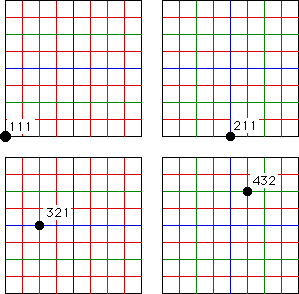
T1(x, y) = (x/2, y/2)
T2(x, y) = (x/2, y/2) + (1/2, 0)
T3(x, y) = (x/2, y/2) + (0, 1/2)
T4(x, y) = (x/2, y/2) + (1/2, 1/2)
giving the unit square (see addresses), we see
diam(Ti(S)) = sqrt(2)/2
diam(TjTi(S)) = sqrt(2)/4
and in general
diam(TiN...Ti1(S)) = sqrt(2)/(2N)
Thus if we take N large enough that sqrt(2)/(2N) < resolution, then the Random Algorithm will fill in the picture to the desired resolution if all regions of address length N are visited. Why should the Random Algorithm do this?
First, recall the Random Algorithm starts with the fixed point of one of the Ti. For definiteness, say we start with the fixed point (x0, y0) of T1. The address of this point is 111... = 1infinity. Suppose the first transformation applied is Ti1. Then (x1, y1) = Ti1(x0, y0) has address i1111... = i1(1infinity). Continuing,
(x2, y2) = Ti2(x1, y1) has address i2i1(1infinity)
(x3, y3) = Ti3(x2, y2) has address i3i2i1(1infinity)
...
(xN, yN) = TiN(xN-1, yN-1) has address iN...i2i1(1infinity)
(xN+1, yN+1) = TiN+1(xN, yN) has address iN+1iN...i2i1(1infinity)
...
Keeping track of the regions of address length N visited by these points, we see
(x0, y0) belongs to the region with address 111...1 = 1N
(x1, y1) belongs to the region with address i1 1N-1
...
(xN, yN) belongs to the region with address iN...i2i1
(xN+1, yN+1) belongs to the region with address iN+1...i3i2
...
So we see each new transformation applied has this effect on the N-digit address: discards the right-most digit, shifts the remaining N-1 one place to the right, and inserts the new address on the left. If the transformations are applied randomly, then eventually every finite sequence of transformations will occur, and in particular, every sequence of length N will be applied. Consequently, every region with address length N will be visited by the (xik, yik). To the specified resolution, the Random Algorithm will generate the same picture as the Deterministic Algorithm.
For example, suppose N=3 and we start with the point 1infinity. To the specified resolution, this point lies in the region with address 111. If T2 is the first transformation applied, the resulting point lies in the region with address 211. If T3 and then T4 are applied, the points lie in the regions with address 321 and 432. Continuing will fill in all the 43 regions of address length 3.

|
Finally, note:
1. Using a random number generator is not the most efficient way to visit all regions of address length N. With some cleverness, specific orderings can be constructed to visit all regions more quickly.
2. Even in the limit of infiitely many applications, the Random Algorithm generates only countalbly many points, whereas the Determinisitc Algorithm typically produces an uncountable point set. For these methods to produce the same picture, we must modify the Random Algorithm by defining the set it produces to be the closure of the countable set.
3. For IFS with nonlinear transformations (e.g., Julia sets, circle inversion limit sets) the contraction factor varies with location, so under the Random Algorithm some regions may fill in very slowly indeed.
Return to Random IFS